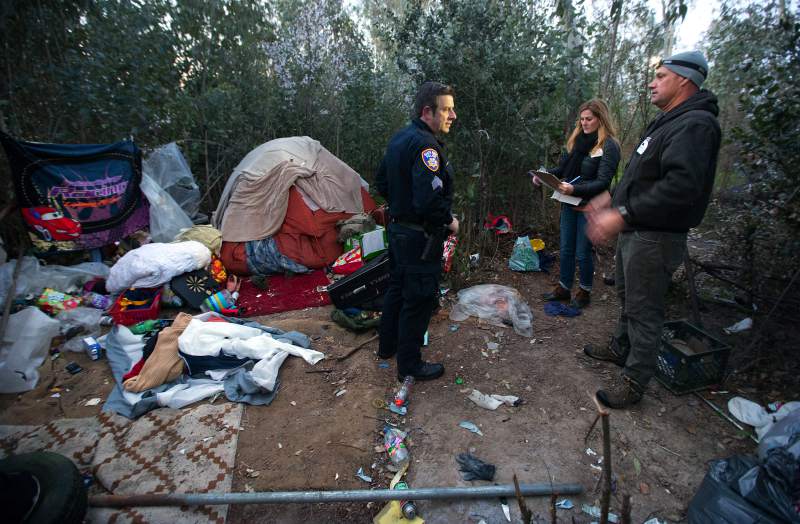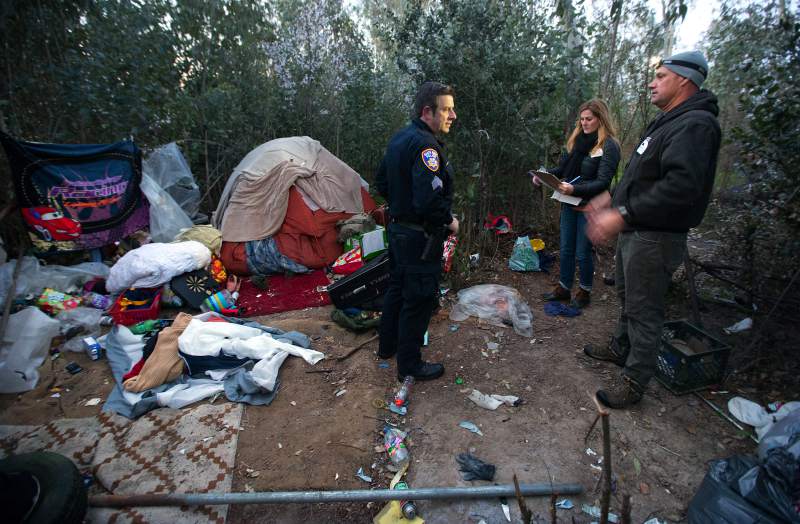Press Democrat // John Burgess
Due to many factors including unemployment, lack of affordable housing, poor physical or mental health and drug and alcohol abuse, homelessness appears to be on the rise in Sonoma County.
According to the Catholic Charities of the Diocese of Santa Rosa, 35 percent of people homeless in Santa Rosa have some form of physical or medical disability.
While these are not the only contributing factors, they do blend together in the lives of those who struggle with homelessness daily. Jennielynn Holmes, senior director of shelter and housing at Catholic Charities of the Diocese of Santa Rosa, said that contributing factors specific to Sonoma County are hard to pinpoint because “it’s always a conditional situation. It could be a combination of things, but it is usually a pretty traumatic event.”
Early Friday morning, 150 volunteers and 70 paid homeless guides set out to conduct the Point-in-Time Homeless Census and Survey in Sonoma County. The county, contracted with Applied Survey Research, has conducted this census annually since 2015 to count how many homeless people are currently residing there.
Divided into teams, volunteers and guides set out, following maps and specific tracts that they planned before their early morning count. Officials pre-determine many of the locations on these tracts including places such as large group encampments, cars, beneath bridges and more secluded tent sites.
Equipped with headlamps, flashlights and clipboards, the crew set out for Piner Road, where an open field was their first stop. The guides leading each team knew exactly where to go and even knew some individuals personally within the homeless population because they were people who had experienced homelessness before.
This detail is crucial, Holmes explained, because “homeless people are more likely to trust a peer, over a random stranger, which is why we have the homeless guides.”
While Sonoma County designed the survey to help evaluate and conquer the homelessness seen in Sonoma County, the fires in October may create a set back to the progress made in the area.
During the census Holmes said they ran into more people in vehicles than expected. “We think it may be because of the fires, people may have lost their homes but not their vehicles,” she said. In addition to car living situations, Holmes added, “there were some pretty large encampments we found, with about 30-40 people living in them.”
In the United States, 11 million families are at risk of becoming homeless due to having to pay at least half of their income toward housing. According to Catholic Charities of the Diocese, a minimum wage full-time worker earns 33 percent of what they would need to afford a two-bedroom, fair market rate apartment in the area. The census is “eye opening” Holmes said, “to see the conditions people are living in, especially in a county as wealthy as ours.”
In a massive effort to help combat these statistics, Catholic Charities operates three emergency overnight shelters and a day center in Santa Rosa, and collectively serves 3,000 homeless children and adults each year. In response to the growing homelessness situation in Sonoma County, Catholic Charities offers a multitude of opportunities for families to have access to safe places to sleep, or even just to park their cars which many live in.
“The census is definitely a huge endeavor that takes a lot of time. The fires have increased workload for Catholic Charities because there are more people in need of our services,” Holmes added.
With nearly 500 people in Santa Rosa who are chronically homeless, meaning they are homeless, disabled and have either been continuously homeless for one year, or had at least four episodes of homelessness in the past three years, Catholic Charities has its hands full. With high hopes, Holmes and Catholic Charities are pressing forward to gather more data and information to better evaluate their next move.
“The census is good for two reasons,” Holmes said. “It helps shine a light on the condition of homelessness and helps to inform progress and strategy moving forward with homelessness.”





![[Both photos courtesy of sonoma.edu]
Ming-Ting Mike Lee stepped in as the new SSU president following Sakakis resignation in July 2022](https://sonomastatestar.com/wp-content/uploads/2024/04/CC4520AB-22A7-41B2-9F6F-2A2D5F76A28C-1200x1200.jpeg)



























